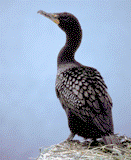United States Department of Agriculture, National Wildlife Research Center: Symposia

Symposium on Double-Crested Cormorants: Population Status and Management Issues in the Midwest
Date of this Version
December 1997
Abstract
Modeling indicated that lowering the doublecrested cormorant population from 17,361 to 10,000 pairs could be attained only by a combination of techniques: culling breeding birds in arboreal colonies to lower breeding stock and egg spraying in accessible ground nests to lower recruitment. The 5-year program was launched in 1989; culling was halted 4 years later because the population had fallen below the threshold of 10,000 breeding pairs. A greater vulnerability of males to shooting (203:100) probably accounted for the faster-than-predicted drop in numbers. Egg spraying spanned the entire 5-year period, during which 25,095 nests were treated with inert mineral oil. As predicted by the model, spraying lowered recruitment, but only after a 2-year lag. Culling should be considered a last-resort form of intervention whenever softer techniques (egg spraying, mechanical nest destruction, and carefully planned disturbances to the nesting colonies to enhance predation and abandonment) are not sufficient or practical to produce population control. Population control should be based upon careful planning (including detailed censuses, population modeling, and prior communication with the public) and be conducted under close scientific supervision.

